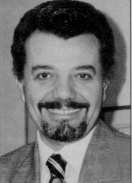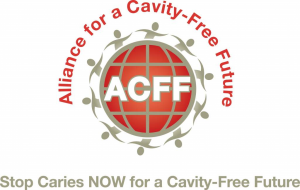
NEWSLETTER Number Three September 1996
Editorial
Report from the education Committee, Goran Dahlof
Report on the 3d Congress of the European Academy of Paediatric Dentistry, Bruges, Belgium, June 7-11 1996
Abstracts and Reviews
Absrtacts and reviews section
Profile: Martin Curzon
|
Message from the President. Constantine J Oulis |
|
As we sit in our office in Leeds Dental Institute preparing for the September copy of the EAPD Newsletter our problem, as always, is finding enough material to fill it. We are told that the Academy can afford to produce a larger newsletter, but this will not find much favour if it is full of empty pages. Write and tell us about meetings you have been to, articles you have read, what you think is good and bad about paediatric dentistry in your country, new techniques and materials you have discovered or old techniques you would not be without. It is only by such an exchange of views that Europe can distill the best of its children's dentistry and achieve excellence. Where better for such an exchange of views than in the European Academy for Paediatric Dentistry Newsletter. Sue Hickson, Maxine Pollard |
|
The final draft of the Curriculum guidelinesfor education and training in Paediatric Dentistry was approved by the general council at the EAPD Congress in Bruges. By the year 1998 future postgraduate programmes in Paediatric Dentistry should be a minimum of 3 years (4800 hours) duration. A complete review of postgraduate programmes in Paediatric Dentistry of 2 years or more was made. On the basis of this data a definite set of main goals, programme objectives and general and specific conditions was made. At the general assembly of the first EAPD meeting in Leeuwenhorst in 1992, the education committee (EC) was installed, consisting of Luc Martens (Belgium) - Chairman, Satu Alalusuua (Finland), G?ran Dahl?f (Sweden), Frans Frankenmolen (The Netherlands), Barry Sheer (UK) and Lisa Papagiannoulis (Greece). |
|
Congress in Athens 1994. A panel of 15representatives of European countries discussed with the members of the EC and the task force these proposals. After all comments and suggestions for revision had been taken into account a final programme was presented and approved by the General Assembly at the third EAPD congress in Bruges 1996. Copies of this programme can be obtained from the editorial office in Leeds. Guidelines and quality assurance criteria for paediatric oral health care is the first priority for the EC during the next two years. For the next two-year period the EC will concentrate on two major issues. First, At the meeting in Bruges, Anna-Karin Holm (Sweden), Luc Marks (Belgium) and Maxine Pollard (UK) were elected to the EC replacing Luc Martens and Barry Sheer. |
|
The historic medieval city of Bruges provided the venue for this, the 3rd Congress of the Academy. Bruges is A number of very successful pre-congress courses, including topics such as traumatology, conscious sedation, interceptive orthodontics and nursing caries, were held over the three days preceding the main congress. The opening ceremony of the congress itself was held on the Saturday evening, the highlight of which was a delightful musical presentation by local children dressed in traditional costume. Keynote symposia were held on each day of the conference, with invited international speakers presenting and discussing the latest developments in the fields of developmental disturbances, fluoride releasing adhesives and the dental needs of the European child. Running parallel with these symposia, were oral and poster research presentations. Over 120 presentations were given by researchers from all parts of the continent and other parts of the world, including USA, Australia |
|
and New Zealand. Contributions were generally of a very high quality and covered all conceivable aspects The conference was further enhanced by an excellent trade exhibition. Amongst many stands, a favourite was that of Kodak who provided free kites. (Careful post-conference evaluation of this product by the authors' children confirms that they fly well, even in light winds !) An entertaining and varied social programme complemented the scientific aspects of the congress, the high point of which was the delicious Burgundian Banquet held on the Monday evening at the Belfry which has an impressive 83metre high tower housing 47 bells. During this most enjoyable evening, delegates were treated to a demonstration of falconry, live table-side entertainment from conjurors and they could even try their skill at a medieval target-practice game which resembled a cross between darts and bar-skittles. Overall the conference was, in all respects, a resounding success, an achievement which reflects the dedicated hard work of Professor Luc Martens and his excellent team. Only one criticism ... we have to wait another two years before the next congress in Porto Cervo, Italy.
|
|
Subluxation of maxillary primary anterior teeth: epidemiology and prognosis of 207 traumatized teeth. This retrospective study investigated the epidemiology, prognosis and sequelae of 207 subluxated primary incisors in 134 patients. The age at time of injury ranged from 0.8 years to 7.5 years with a mean of 3.5 years. The most commonly involved tooth was the primary maxillary central incisor, the most common cause of injury being falls indoors. Two thirds of teeth had abnormally increased mobility. No active treatment was prescribed for 80% of teeth, 9.2% were extracted and 9.6% were splinted. Patient discomfort and occlusal interference were not common. Discolouration and pulp calcification Dental disease, caries related microflora and salivary IgA of children with severe congenital heart disease. This study aimed to compare levels of dental caries, plaque accumulation, gingivitis, oral loading of specific microorganisms, salivary IgA and dental health knowledge in children with severe cardiac disease with healthy controls. 60 children from a London hospital were studied with 60 cross-matched control children being identified from those attending |
|
Dental electro-anaesthesia in children: a pilot study. This study investigated the efficacy of an electronic dental anaesthesia system (Cedeta Mk II) for pain control during restorative dentistry in children. Sixty-six children aged 10-17 years had restorations placed using the electronic anaesthesia system. A control group of 121 similar children was treated using routine local analgesia. Following treatment, both groups were asked to report any pain experienced using a 10 point analogue scale. The study group had significantly higher pain scores than controls (p<0.001). Almost 70% of controls scored the painfulness of the procedure at 1 or less on the ten point scale. Conversely, less than 3% of the study group had pain scores this low. In 27% of the study group, treatment had to be stopped and then continued under local analgesia. The authors conclude that although further treatment was warranted to assess the application of this technique to special groups, dental electro-anaesthesia did not yet appear to be an acceptable substitute for local anaesthesia by injection in routine paediatric dental Maxillary canine impaction in patients with transverse maxillary deficiency. The purpose of this retrospective study was to determine whether patients with impacted maxillary canine(s) have transverse maxillary deficiency compared with subjects without impacted canines. Study models of 57 individuals with a total of 81 impacted canines were analysed. 103 non-impaction subjects were used as controls. In keeping with previous studies, the ratio of palatal to buccal impactions was 2.5:1. However 27% of impactions were bilateral, a much higher proportion than previously reported. Mean intercanine width was significantly less in the study group when compared to controls. Archshape, intermolar width, arch length and arch perimeter were similar in study and control groups. A significant difference was demonstrated in the intercanine / intermolar ratio (0.8 for the study group, 0.9 for controls) which may suggest that this parameter could be useful as a predictor of the need for surgical/orthodontic intervention. |
|
There followed two and a half years at the Eastman Dental Center (Rochester, New York) training under Roland Hawes and Basil Bibby, gaining a Master's degree at the same time as a speciality certificate. Finishing this course, but without a job to go to Martin was eventually hired to treat Eskimo children living on Hudson Bay. After six months of travel in the Arctic he was appointed Lecturer in Paedodontics at Bristol University. However, the travel bug soon caught hold again and by the end of 1970 Martin was back in the Canadian high Arctic as Senior Dental Officer on Baffin Island. Faced with a population of 7,000 Eskimos spread out over an area of 40,000 square miles, with extensive levels of disease and a team of two other dentists, he had a hard task to visitevery settlement on a regular basis to provide prevention and dental care. In December 1972 Martin Curzon returned to the Eastman in Rochester to start a ten year project on trace elements and |
|
dental disease. On the retirement of Fred Losee he was appointed Chairman of Caries Research but at the same time continued to teach and practice Paediatric Dentistry. During this period of his career he developed Masters programmes in research as well as supervising postgraduate students in Paediatric Dentistry. A desire to get back into clinical treatment and teaching eventually led him to leave Rochester and in July 1983 he was appointed Professor of Child Dental Health and Consultant in Paediatric Dentistry, in Leeds, England. Over the past thirteen years Martin has concentrated on developing the postgraduate and undergraduate clinical, teaching and research programmes in Paediatric Dentistry at Leeds. Over this period of time some 42 dentists have qualified as specialists, many going on to become teachers in their own right. The programme at Leeds has now been passed on to Maxine Pollard and Martin is now responsible for the overall supervision of taught postgraduate courses for the whole of the dental school. He still undertakes clinical work on a weekly basis; teaching clinics and consulting sessions occupy six half days a week and research the rest. He says that the clinical aspect of his work still means the most to him and the greatest satisfaction is to see young students develop an expertise in the management of preschool children. He is a noted author of many papers, and in recent years, of textbooks in Paediatric Dentistry. In his `spare' time he enjoys walking the Dales and Fells of Yorkshire, tending his extensive garden of flowers and vegetables and as he says `just enjoying life'. |

 The 3rd EAPD CONGRESS at BRUGES was a great success. When our past President Goran Koch wrote his President's message in the 1994 Newsletter referring to the Athens Congress, I think that numerous members could not imagine that such a success could be repeated, or that the high standards which many people, including Luc Martens, felt were established then could be maintained. However, two years later Luc Martens, with his dedicated and hard-working group, achieved what seemed impossible. They succeeded in organising a conference which surpassed the previous one in many ways and fixed even higher standards for the future, leaving a difficult assignment for the next organisers. The programme ran extremely smoothly and even using four different locations simultaneously led to only very minor problems. Assigning people to specific jobs was an excellent idea and problems could be solved immediately by the appropriate person.
The 3rd EAPD CONGRESS at BRUGES was a great success. When our past President Goran Koch wrote his President's message in the 1994 Newsletter referring to the Athens Congress, I think that numerous members could not imagine that such a success could be repeated, or that the high standards which many people, including Luc Martens, felt were established then could be maintained. However, two years later Luc Martens, with his dedicated and hard-working group, achieved what seemed impossible. They succeeded in organising a conference which surpassed the previous one in many ways and fixed even higher standards for the future, leaving a difficult assignment for the next organisers. The programme ran extremely smoothly and even using four different locations simultaneously led to only very minor problems. Assigning people to specific jobs was an excellent idea and problems could be solved immediately by the appropriate person.

 Born in Greenwich (England) Martin Curzon spent his early years in London andattended dental school at University College London, qualifying in1964. After a short time in dental practice and as a House Surgeon, a desire to travel and see the world took him to (British Columbia Canada). For two years Martin was a `paedodontic extern' which meant moving from village to village providing dental care for children. These settlements were remote mining camps, Indian reservations and fishing villages and were often only visited once every 18-24 months. Levels of dental decay were high and so the two years he spent there was an invaluable experience and confirmed his decision to specialise in Paediatric Dentistry.
Born in Greenwich (England) Martin Curzon spent his early years in London andattended dental school at University College London, qualifying in1964. After a short time in dental practice and as a House Surgeon, a desire to travel and see the world took him to (British Columbia Canada). For two years Martin was a `paedodontic extern' which meant moving from village to village providing dental care for children. These settlements were remote mining camps, Indian reservations and fishing villages and were often only visited once every 18-24 months. Levels of dental decay were high and so the two years he spent there was an invaluable experience and confirmed his decision to specialise in Paediatric Dentistry.

